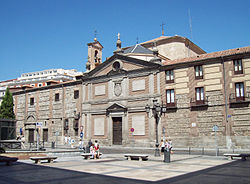Descalzas Reales
| Convent of las Descalzas Reales | |
|---|---|
|
Native name Spanish: Monasterio de las Descalzas Reales |
|
 |
|
| Location | Madrid, Spain |
| Coordinates | 40°25′06″N 3°42′22″W / 40.418267°N 3.706192°WCoordinates: 40°25′06″N 3°42′22″W / 40.418267°N 3.706192°W |
| Official name: Monasterio de las Descalzas Reales | |
| Type | Non-movable |
| Criteria | Monument |
| Designated | 1994 |
| Reference no. | RI-51-0008691 |
The Convent of Las Descalzas Reales (Spanish: Monasterio de las Descalzas Reales) is a royal monastery situated in Madrid, Spain, administered by the Patrimonio Nacional.
The Monasterio de las Descalzas Reales, literally the "Monastery of the Royal Barefooted", resides in the former palace of King Charles I of Spain and Isabel of Portugal. Their daughter, Joanna of Austria, founded this convent of nuns of the Poor Clare order in 1559. Throughout the remainder of the 16th century and into the 17th century, the convent attracted young widowed or spinster noblewomen. Each woman brought with her a dowry. The riches quickly piled up, and the convent became one of the richest convents in all of Europe. Tomás Luis de Victoria, Spain's finest Renaissance composer, worked at the convent from 1587 to the end of his life in 1611.
The demographics of the convent slowly changed over time, and by the 20th century, all of the sisters were in poverty. The convent maintained the riches of its past, but it was forbidden to auction any of the items off or spend any of the money it received from the dowries. The state intervened when it saw that the sisters were poor, and the pope granted a special dispensation to open the convent as a museum in 1960.
Alfonso, Duke of Anjou and Cádiz (died 1989) is buried in the Chapel of Saint John the Baptist next to his elder son Francisco de Asís (died 1984). Alfonso's younger brother Gonzalo (died 2000) is buried in the Chapel of Saint Sebastian.
While in the past, the treasures of the monastery were not visible, today the monastery houses only a few nuns, and the site is a well-visited national monument. The noblewomen's dowries were often invested into relics and their bejeweled exhibition pieces. Among the many relics on display are putatively pieces from Christ's cross and the bones of Saint Sebastian. Among the priceless art masterpieces are Titian's Caesar's Money, tapestries woven to designs by Rubens, and works by Hans de Beken and Brueghel the Elder.
...
Wikipedia

